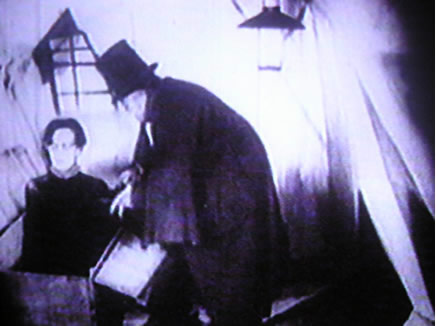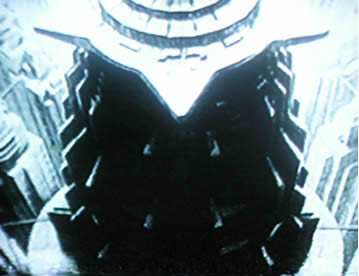German Expressionism Cinema – from Caligari to Metropolis
German Expressionist Cinema, 1917-1929
After World War I, and until the height of Nazism in the early 1930s, Germany was the birthplace of a new style of filmmaking based on the stylistic characteristics of the expressionist movement, such as the use of chiaroscuro, dreamlike atmospheres and exaggerated angles and compositions. The exact date of the birth of this movement is around 1917, when the Universum Film AG (UFA) was founded by the German government and the German army.
There are countless in-depth studies about this movement in books, magazines and even the Internet, but this short essay deals only with the author’s personal reflections on the films he had the opportunity to see – and enjoy.

Caligari! CALIGARI!!
Directed in 1919 by Robert Wiene, “The cabinet of Dr. Caligari” is the most paradigmatical film of the early German expressionism.
Brief synopsis: A traveling fair visits a small German village. The main attraction of the fair is the Doctor Caligari booth, where a sleepwalker named Cesare (Conrad Veidt) is advertised. One of the visitors asks the aforementioned sleepwalker a tremendously brainy question, “How long am I going to live?” to which the freak replies, “You’ll die tomorrow.” Curiously, the questioner – instead of laughing his head off – seems very concerned about the sleepwalker’s prediction. Also curiously, he dies the day after.
The art direction of the film was in charge of Walter Reimann and Walter Roehrig, former members of the “Der Sturm group”, a Berlin expressionist movement, which included artists such as Bruno Taut or Herwarth Walden. Both created an original and fantastic atmosphere that fills the film with a delirious atmosphere, and emphasizes the mental self-destruction of the protagonist.

Caligari’s brutal domination of his half-sleepwalker / half-zombie Cesare is easily interpretable as a metaphor for the fascist and authoritarian regimes that arose in Europe in the first half of the 20th century, as Siegfried Kracauer has explained in his famous book From Caligari to Hitler.
“And when he crossed the bridge, the phantoms came to meet him.”
Don’t ask me how, but a few years ago I was lucky enough to get my hands on a copy of the earliest of Friedrich Murnau’s surviving films: Schloß Vogeloed (The Haunted Castle). Not that I was enthusiastic about the film, but the beauty of the photography, the strange and disturbing ending, and the striking use of chiaroscuro were enough to introduce me to Murnau’s universe, which reaches its zenith with the film we will now review.

A year after completing Schloß Vogeloed , Murnau was ready to film his undisputed masterpiece: Nosferatu, eine symphonie des grauens is based on the novel Dracula , by Bram Stoker, but a lawsuit with the writer’s widow forced Murnau to change some details of the film, such as the title or the name of the protagonist (Count Orlok, instead of Count Dracula) However, this was not enough, and, due to the lawsuit, almost all copies of the film were destroyed. Deutsche Film Production was able to save one of them, and the film was finally released in the United States in 1929.

The incredible performance of Max Schreck as the sinister Count Orlok (extremely thin, pale, rat-toothed, raven-nosed, like a Transylvanian version of Mr. Burns from the Simpsons), the charm of the landscapes and the beauty and lyricism of the texts place the film at the top of the horror genre. Nosferatu is the most cryptic and necrophiliac, but also dreamlike and romantic of all the films based on the Transylvanian vampire, a masterpiece that neither Tod Browning, Terence Fisher or Francis Ford Coppola have been able to surpass.

Metropolis
Along with Stanley Kubrick’s 2001, A Space Odyssey (1968) and Ridley Scout’s Blade Runner (1982), Fritz Lang’s Metropolis is considered the pinnacle of the not always well named science fiction cinema. The influence on the two later films is evident: the opening sequences of dark, futuristic, neo-industrial Los Angeles seem to pay tribute to the urban landscapes of Metropolis (see photo left), while in Kubrick’s masterpiece the homage is even in the title: 2001 is set in that year in homage to Fritz Lang’s film, set in the year 2000.

But while the “predictions” of “Blade Runner” and “2001” have turned out to be quite wrong (the replicants -as far as I know- are not even in the project phase yet, and Saturn is still quite unreachable), the fatalistic vision that Metropolis makes of the abuses to which the working class is subjected is a cruel metaphor still valid today. Almost 40 years later, and without referring to the film, Julio Cortázar wrote in a letter a quote that sums up the tragic message of Metropolis: “humanity will truly begin to deserve its name the day when the exploitation of man by man will have ceased”.

Follow us on:


